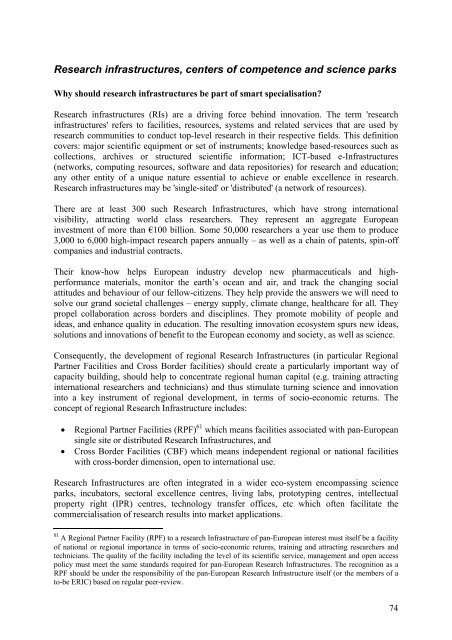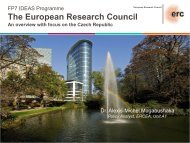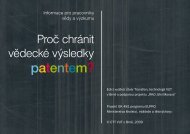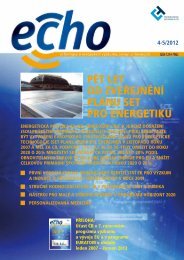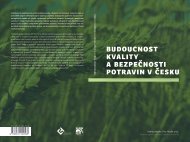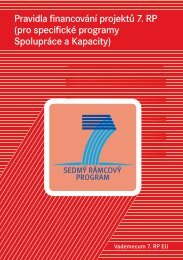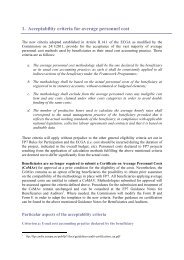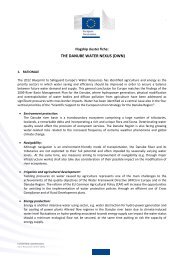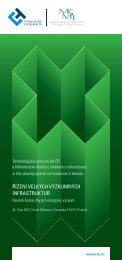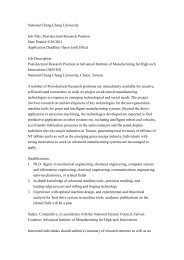Guide to Research and Innovation Strategies for Smart Specialisation
Guide to Research and Innovation Strategies for Smart Specialisation
Guide to Research and Innovation Strategies for Smart Specialisation
Create successful ePaper yourself
Turn your PDF publications into a flip-book with our unique Google optimized e-Paper software.
<strong>Research</strong> infrastructures, centers of competence <strong>and</strong> science parks<br />
Why should research infrastructures be part of smart specialisation?<br />
<strong>Research</strong> infrastructures (RIs) are a driving <strong>for</strong>ce behind innovation. The term 'research<br />
infrastructures' refers <strong>to</strong> facilities, resources, systems <strong>and</strong> related services that are used by<br />
research communities <strong>to</strong> conduct <strong>to</strong>p-level research in their respective fields. This definition<br />
covers: major scientific equipment or set of instruments; knowledge based-resources such as<br />
collections, archives or structured scientific in<strong>for</strong>mation; ICT-based e-Infrastructures<br />
(networks, computing resources, software <strong>and</strong> data reposi<strong>to</strong>ries) <strong>for</strong> research <strong>and</strong> education;<br />
any other entity of a unique nature essential <strong>to</strong> achieve or enable excellence in research.<br />
<strong>Research</strong> infrastructures may be 'single-sited' or 'distributed' (a network of resources).<br />
There are at least 300 such <strong>Research</strong> Infrastructures, which have strong international<br />
visibility, attracting world class researchers. They represent an aggregate European<br />
investment of more than €100 billion. Some 50,000 researchers a year use them <strong>to</strong> produce<br />
3,000 <strong>to</strong> 6,000 high-impact research papers annually – as well as a chain of patents, spin-off<br />
companies <strong>and</strong> industrial contracts.<br />
Their know-how helps European industry develop new pharmaceuticals <strong>and</strong> highper<strong>for</strong>mance<br />
materials, moni<strong>to</strong>r the earth’s ocean <strong>and</strong> air, <strong>and</strong> track the changing social<br />
attitudes <strong>and</strong> behaviour of our fellow-citizens. They help provide the answers we will need <strong>to</strong><br />
solve our gr<strong>and</strong> societal challenges – energy supply, climate change, healthcare <strong>for</strong> all. They<br />
propel collaboration across borders <strong>and</strong> disciplines. They promote mobility of people <strong>and</strong><br />
ideas, <strong>and</strong> enhance quality in education. The resulting innovation ecosystem spurs new ideas,<br />
solutions <strong>and</strong> innovations of benefit <strong>to</strong> the European economy <strong>and</strong> society, as well as science.<br />
Consequently, the development of regional <strong>Research</strong> Infrastructures (in particular Regional<br />
Partner Facilities <strong>and</strong> Cross Border facilities) should create a particularly important way of<br />
capacity building, should help <strong>to</strong> concentrate regional human capital (e.g. training attracting<br />
international researchers <strong>and</strong> technicians) <strong>and</strong> thus stimulate turning science <strong>and</strong> innovation<br />
in<strong>to</strong> a key instrument of regional development, in terms of socio-economic returns. The<br />
concept of regional <strong>Research</strong> Infrastructure includes:<br />
• Regional Partner Facilities (RPF) 61 which means facilities associated with pan-European<br />
single site or distributed <strong>Research</strong> Infrastructures, <strong>and</strong><br />
• Cross Border Facilities (CBF) which means independent regional or national facilities<br />
with cross-border dimension, open <strong>to</strong> international use.<br />
<strong>Research</strong> Infrastructures are often integrated in a wider eco-system encompassing science<br />
parks, incuba<strong>to</strong>rs, sec<strong>to</strong>ral excellence centres, living labs, pro<strong>to</strong>typing centres, intellectual<br />
property right (IPR) centres, technology transfer offices, etc which often facilitate the<br />
commercialisation of research results in<strong>to</strong> market applications.<br />
61 A Regional Partner Facility (RPF) <strong>to</strong> a research Infrastructure of pan-European interest must itself be a facility<br />
of national or regional importance in terms of socio-economic returns, training <strong>and</strong> attracting researchers <strong>and</strong><br />
technicians. The quality of the facility including the level of its scientific service, management <strong>and</strong> open access<br />
policy must meet the same st<strong>and</strong>ards required <strong>for</strong> pan-European <strong>Research</strong> Infrastructures. The recognition as a<br />
RPF should be under the responsibility of the pan-European <strong>Research</strong> Infrastructure itself (or the members of a<br />
<strong>to</strong>-be ERIC) based on regular peer-review.<br />
74


